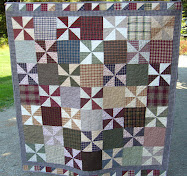Bobbi posed a great question on my last blog post...
"what would you use the elderberry tincture for and how exactly would you use it?"
Well, thanks for asking Bobbi. Here we go...
Elderberry (Sambucus nigra, S. canadensis)
is a flowering shrub/tree that grows throughout Europe and N. America.
You want to use the varieties that produce blue berries. (Some are more on the black side- just not the red variety as the berries are toxic.)
What can you do with elderberry?
-You can pick the white flowered clusters and fry them as flower fritters or make a tea or tincture from them.
-You can pick the berries and turn them into syrup for pancakes, jams, and jellies.
-You can eat the berries fresh, but I wouldn't recommend eating bunch of them that way.
-You can make tinctures and cough syrups with the berries.
-You can dry the berries for future use.
To say what Elderberry is good for is to write a chapter of a book! It is commonly used for the respiratory tract, the digestive tract, the kidneys, the female system, the pores of the skin, fevers, ulcers, wounds....
Regarding the doctrine of signatures with Elder, Matthew Wood has this to say:
"The hollow tubes of the young branches not only point to the use of this plant in journeying, but show affinities with the tubes of the body, especially the blood vessels and pores of the skin and membranes. Elder has a powerful influence on the blood, to remove stagnation found in bruises and boils. It also decongests heat and stirs up the blood in the interior, bringing it to the surface to remove heat and toxins.....Elder has a deep action on other tubular structures of the body, including the respiratory tract, digestive organs, and pores of the skin. It is an ancient remedy for opening the lungs and bringing up mucus."
As far as usage, the dosage depends on who you talk to. Different herbalist have different recommendations. I tend to use anywhere from a few drops to a half a dropperful in water. It all depends on the tincture and what you're taking it for.
The idea of "if a little is good, more is better" is not the best thought process when it comes to herbs.
If you're interested in learning more about the plants that God has provided here for us as medicine, I'd strongly suggest picking up a few herb books at your library or on Amazon, utilizing sites like Leanringherbs.com, Mountainroseherbs.com, bulkherbstore.com, methowvalleyherbs.com, or finding an herbalist in your area that can help.
Tricia also asked where I got my dried elderberries from?
Up until now I have purchased them from Mountain Rose Herbs. But this past fall I finally invested in an Elderberry tree from here. And this spring, invested in another one from here. This one is on my list, but the sale is prohibited to California. (Dont'cha just LOVE the government??!!)
Hopefully the purchasing of dried berries is now in my past!
You can wildcraft them. I haven't found any locally here but have seen them up at higher elevations, deep into the mountains near streams.
I hope I answered your questions as well as you'd hoped and that the information is useful!




.jpg)

















































5 comments:
Our family has been using elderberry syrup for three years now during cold and flu season. It's high time I planted a bush too.
What's the difference in Alleso and Adams?
The Alleso is S.nigra and the Adams is s.canadensis. They can be used interchangeably. :)
I believe that the S. Canadensis is prohibited because the plant is native to n.America and is most likely considered "invasive" by the ridiculous lawmakers in California. :)
Awesome, thanks for the response! I am in FL so I guess it is probably too hot, but the dried berries will work for us. I do want to learn more about herbs and such. Can you recommend a particular book, or just start anywhere?
Well I can only recommend what I did. There are so many ways of going about it to learn...especially if you're in a more urban area with classes and such.
I started with learningherbs.com and tried to glean as much info as I could there.
They have a sister web-site, herbmentor.com. There is a fee for using that site though. I believe when I used it, it was $9.99/month. I don't currently have a subscription to it now but I may re-join in the future. It is FULL of information as well as some REALLY knowledgeable people.
I have 4 herb books but my favorite HANDS DOWN is Matthew Wood's "The Book of Herbal Wisdom". It is wonderful. I have read, and re-read and highlighted, and underlined, and dog-eared the pages... If I could only pick one then that's the one I'd choose.
The book does not cover every herb though. I know that there are some out there that cover 500 herbs or whatever but this one extensively goes over 41.
And then after that, the best thing to do is to go outside and start finding herbs. I began looking everywhere I went.
My oldest would jokingly complain every time we went somewhere new, "Oh boy, what herb are you going to show us from here?"
Looking in a book at a picture is one thing, seeing it in real life and being able to identify it is another.
I still have SO FAR to go in my research and learning. I'm like a wee babe in the realm of herbalism. :)
I hope that you find the blessings in your journey into the wonderful world of the herbs God created!
Post a Comment